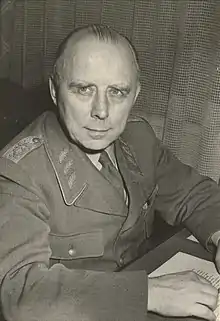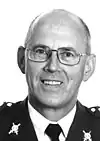| Swedish Army Service Troops | |
|---|---|
| Trängtrupperna | |
 Branch insignia m/60. | |
| Active | 1885–present |
| Country | Sweden |
| Allegiance | Swedish Armed Forces |
| Branch | Swedish Army |
| Type | Logistics |
| Part of | Swedish Armed Forces Headquarters[lower-alpha 1] |
| Insignia | |
| Cap badge |  |
The Swedish Army Service Troops (Swedish: Trängtrupperna, T or Underhållstrupperna, before 1942 called Trängen) is the military logistics (or train) branch of the Swedish Army. The task of the troops is to train personnel for maintenance units, provide supplies, repair damaged equipment, retract and care for sick personnel as well as in the event of war mobilizing them. The troops are today fully motorized.
History

In 1885, the first army service unit was established, the Logistic Battalion (Trängbataljonen) in Marieberg, Stockholm. It was divided into the Svea Logistic Battalion (T 1) and the Göta Logistic Battalion (T 2) in 1891, the latter being placed in Karlsborg. According to the Defence Act of 1892, two new logistic battalions, Norrland Logistic Battalion (T 3) in Sollefteå and Wendes Logistic Battalion (T 4) in Landskrona were established. Through the Defence Act of 1901, two further logistic units (now called corps) were established, so that there would be one logistic unit for each army division.[1] These were the 2nd Svea Logistic Corps (T 5) and 2nd Göta Logistic Corps (T 6), which were placed in Sala (1906), and in Linköping (1911) respectively. They changed names in 1904 to Västmanland Logistic Corps (T 5), and Östgöta Logistic Corps (T 6). Meanwhile, Wendes Logistic Corps changed name to Scanian Logistic Corps. In 1905, Göta Logistic Corps moved to Skövde and in 1907 Svea Logistic Corps moved to Örebro and Scanian Logistic Corps moved to Hässleholm.[1]

In the Defence Act of 1914, an inspector (colonel) became the highest guardian of the army service corps. By now it occupied 87 officers plus 6 regimental physicians and 6 battalion physicians, 6 battalion veterinarians and regimental pastors.[2] According to the Defence Act of 1925, Västmanland and Östgöta Logistic Corps were disbanded, while Svea Logistic Corps was placed in Linköping.[1] The Swedish Army Service Troops now consisted of the Inspector of the Swedish Army Service Troops with staff as well as four corps'. In each corps, a train, an automobile and a medical company were organized.[3] In the Defence Act of 1942, the Swedish Army Service Troops were significantly expanded and an independent logistic company was established in Nora (T 2 N), disbanded in 1952. After the independent commissariat and ordnance companies were transferred to the army service troops, the corps became regiments (1949). In 1954 there were Svea Logistic Regiment (T 1) in Linköping, Göta Logistic Regiment (T 2) in Skövde, Norrland Logistic Regiment (T 3) in Sollefteå and Scanian Logistic Regiment (T 4) in Hässleholm.[1] Officers where trained at the Swedish Army Service Troops Cadet School (Trängtruppernas kadettskola, TrängKS) 1942–1961, the Swedish Army Service Troops Cadet and Officer Candidate School (Trängtruppernas kadett- och aspirantskola, TrängKAS) 1961–1981, the Swedish Army Service Troops Officers College (Trängtruppernas officershögskola, TrängOHS) 1981–1991 and the Swedish Army Maintenance Center (Arméns underhållscentrum, UhC) 1991–1997.
Since 2004, the only remaining unit of the Swedish Army Service Troops is the Logistic Regiment (TrängR) in Skövde. It consists, among other units, of the 1st and the 2nd Logistics Battalions, which has the tasks of supplying materiel such as fuel, ammunition, food, water and other equipment to the units of the Swedish Armed Forces. The battalions are organized with one battalion staff, one command company and three logistics companies. In peacetime, the battalions has one medical reinforcement company each.[4]
Uniforms
Miscellaneous
In 1885 the first uniform of the new army branch was approved. The model was based on the dragoon uniform. The tunic was of dark blue broadcloth, double-buttoned with shoulder straps and medium blue facing fastened with seven silver-coloured buttons of corps model on each side and medium blue piping along the bottom edge.[5] The Prussian collar and cuffs were medium blue and decorated with two white buttonholes. The long trousers and the riding breeches were of dark blue broadcloth and had medium blue piping on the outer seams. Officers had silver-coloured epaulettes with medium blue lining.[5] Headgear was a dark blue cap m/1865 of infantry model or a casque of black leather with plate and chinstrap of silver-plated metal. On parade the point could be exchanged for a drooping plume of black horsehair. A belt of brown leather or, for officers, a blue and yellow sash were worn when needed. For footgear, black boots or riding boots with spurs.[5]
In 1895 a dark blue single-buttoned tunic with medium blue collar and piping along the front and lower edge and on the rear pockets. A white buttonhole with a button on each cuff. Cap m/1865 was replaced by cap m/1886. The casque was kept but from 1895 was called helmet. In 1900 a stable jacket of dark blue broadcloth was introduced for officers and NCOs.[5]
Arms and strappings
The officer's sabre m/1891 was replaced by sabre m/1872 for all personnel. Hand-held firearms were carbine m/1870 and m/1894 while officers had revolver m/1871 and m/1887.[5]
 Tunic m/1895 type II for privates.
Tunic m/1895 type II for privates. Stable jacket m/1871 for a lieutenant in the Svea Logistic Corps (T 1).
Stable jacket m/1871 for a lieutenant in the Svea Logistic Corps (T 1). Riding breeches m/1895 for privates.
Riding breeches m/1895 for privates. Long trousers m/1895 for officers.
Long trousers m/1895 for officers. Helmet m/1885 for privates.
Helmet m/1885 for privates. Helmet m/1885 with plume m/1885 for officers.
Helmet m/1885 with plume m/1885 for officers. Helmet m/1885 for officers.
Helmet m/1885 for officers. Shoulder strap m/1895 for colonel.
Shoulder strap m/1895 for colonel. Shoulder mark m/1910 for colonel.
Shoulder mark m/1910 for colonel. Collar patch m/1958.
Collar patch m/1958.
Inspector of the Swedish Army Service Troops
The commander of the corps was called the Inspector of the Swedish Army Service Troops (Tränginspektören, Trinsp).[6][lower-alpha 2] The Inspector, who also has regimental commander's power and authority of the branch's officers and non-commissioned officers with similarities, had the rank of colonel. In his capacity as branch inspector, and regarding the training of the army service troops, he had the same duties and responsibilities as other inspectors.[8] The Inspector was assisted by a staff, the Army Service Troops Inspectorate (Tränginspektionen). The Inspector was from 1991 to 1997 the head of the Swedish Army Maintenance Center (Arméns underhållscentrum, UhC).
Officeholders
| No. | Portrait | Name | Took office | Left office | Time in office | Chief of the Army Staff |
|---|---|---|---|---|---|---|
| 1 | Major general[lower-alpha 3] Ivar Gewert (1891–1971) | 1942 | 1946 | 3–4 years | Colonel Henry Tottie Major general Hugo Gadd | |
| 1 | Colonel Gottfrid Björck (1893–1981) | 1946 | 1949 | 2–3 years | Major general Ivar Backlund Major general Viking Tamm | |
| 1 | Colonel Knut Hagberg (1895–1988) | 1949 | 1956 | 6–7 years | Major general Viking Tamm Major general Bert Carpelan | |
| 1 | Colonel Adolf Norberg (1900–1988) | 1956 | 1960 | 3–4 years | Major general Bert Carpelan Major general Gustav Åkerman | |
| 1 | Colonel Birger Hasselrot (1905–2001) | 1960 | 1965 | 4–5 years | Major general Gustav Åkerman Major general Arne Mohlin Major general Stig Synnergren | |
| 1 | Colonel Magnus Bruzelius (1912–2004) | 1965 | 1972 | 6–7 years | Major general Stig Synnergren Major general Ove Ljung Major general Karl Eric Holm | |
| 1 | Senior colonel Dag Nordenskiöld (1913–1991) | 1972 | 1974 | 1–2 years | Major general Lennart Ljung | |
| 1 | Senior colonel Börje Wallberg (1923–2014) | 1974 | 1983 | 8–9 years | Major general Gösta Hökmark Major general Robert Lugn | |
| 1 | Senior colonel Curt Sjöö (born 1937) | 1983 | 1987 | 3–4 years | Major general Krister Larsson | |
| 1 | Senior colonel Claës Tamm (born 1931) | 1987 | 1991 | 3–4 years | Major general Krister Larsson Major general Curt Sjöö | |
| 1 | Senior colonel Ragnar Söderberg (born 1935) | 1991 | 1993 | 1–2 years | Major general Lennart Rönnberg | |
| 1 | Senior colonel Lars Nordmark (born 1938) | 1993 | 1997 | 3–4 years | Major general Lennart Rönnberg |
See also
Footnotes
- ↑ The branch was subordinate the Swedish Army Service Troops (Tränginspektören) at the Service Department of the Army Staff from 1942 to 1991. After that, it was subordinate to the commander of the Swedish Army Maintenance Center (1991–1997), the commander of the Swedish Army Center (1997–2000), the Joint Forces Command (2000–2005), and the Swedish Armed Forces Headquarters from 2005.
- ↑ Also translated as the Transportation Corps Inspector.[7] Before 1942 the branch was called Trängen and the inspector was then called Inspektören för trängen.[8]
- ↑ Gewert was colonel when taking office in 1942 and was promoted to major general in 1945 while still in office.
References
Notes
- 1 2 3 4 Carlquist & Carlsson 1955, pp. 1096–1097
- ↑ Westrin 1920, p. 180
- ↑ Bring 1925, p. 277
- ↑ "VÅRA INSATSFÖRBAND" (in Swedish). Swedish Armed Forces. Retrieved 3 July 2020.
- 1 2 3 4 5 Braunstein 2013, p. 42
- ↑ Gullberg 1977, p. 1040
- ↑ Appich 1988, p. 167
- 1 2 Betänkande och förslag rörande den centrala försvarsförvaltningen. Statens offentliga utredningar, 0375-250X ; 1927:29 (in Swedish). Stockholm. 1927. p. 30. SELIBR 1334799.
{{cite book}}: CS1 maint: location missing publisher (link)
- Appich, Thomas W. Jr. (22 July 1988). "Reference Aid Swedish–English Glossary of Military and Technical Acronyms and Abbreviations" (PDF). Joint Publications Research Service. Foreign Broadcast Information Service. p. 167. Archived (PDF) from the original on 20 February 2017. Retrieved 30 October 2018.
- Braunstein, Christian (2013). Svenska arméns uniformer. D. 3, Artilleriet, övriga truppslag och 1900-talets enhetsuniformer [Uniforms of the swedish army. P. 3, Artillery, other branches and standard uniforms of the 20th century] (PDF) (in Swedish). Stockholm: Armémuseum]. ISBN 978-91-86478-43-8. SELIBR 15180486.
- Bring, Samuel E., ed. (1925). Svenska kalendern 1926: en årsbok för alla (in Swedish). Vol. 21. Uppsala: Almqvist & Wiksell. SELIBR 869835.
- Carlquist, Gunnar; Carlsson, Josef, eds. (1955). Svensk uppslagsbok (in Swedish) (2nd, revis. and enlarged ed.). Malmö: Förlagshuset Norden. pp. 1096–1097. SELIBR 11112. Archived from the original on 2014-03-12.
- Gullberg, Ingvar E. (1977). Svensk-engelsk fackordbok för näringsliv, förvaltning, undervisning och forskning [A Swedish-English dictionary of technical terms used in business, industry, administration, education and research] (in Swedish) (2nd ed.). Stockholm: Norstedt. ISBN 91-1-775052-0. SELIBR 8345587.
- Westrin, Theodor, ed. (1920). Nordisk familjebok: konversationslexikon och realencyklopedi (in Swedish). Vol. 30 (Ny, rev. och rikt ill. ed.). Stockholm: Nordisk familjeboks förl. SELIBR 8072220.










